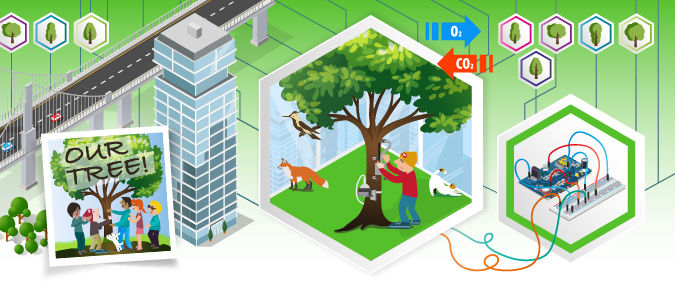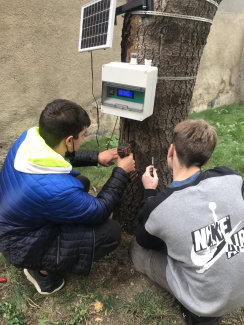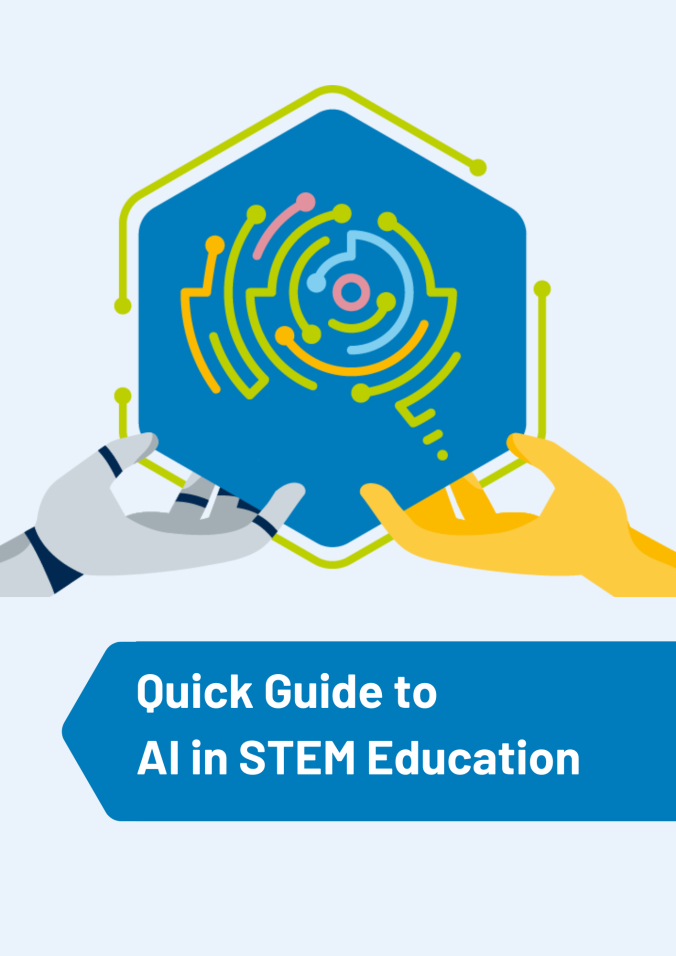Adopt a Tree

Overview
Overview
Keywords: Sustainable forestry, Arduino, sensors, IOT, climate change, remote sensing, ecology, environmental engineering
Disciplines: Physics, chemistry, biology, humanities, natural resources management, technology
Age level of the students: 10-18
Time frame: 1 school year (9 months)
Partners: Nearby schools
![]()
![]()
![]()
Go directly to: Green Almighty, Voltage is Everywhere, Internet of Trees
You can also find an insight into the unit directly from the authors in this webinar (YouTube).
Summary
The aim of the project is the construction of an extended tree network (IoT=Internet of Trees) which will provide the means for protection and conservation of one of the most precious but permanently endangered natural resources, our forests. This is achieved through the assembly, programming and installation of a remote data logger on an “adopted” tree within a forest or a city park. The device records several environmental parameters and their influence on the tree health, and either stores the data locally, to be periodically retrieved, or transmits the telemetry in real time via radio frequencies to the base station (school or elsewhere).
Ask the authors
Forests are the lungs of the environment as they produce most of the oxygen which is needed by almost all living organisms. The reversal of deforestation and environmental pollution is absolutely essential for the balance of our ecosystems.
According to Dr. Robert Jandl and Ms. Reneema Hazarika, guest editors of the Forests special issue The Role of Forests for Achieving the Sustainable Development Goals (SDG),
“Protecting the environment is key to the quality of life, and several SDGs have a strong environmental dimension. Although there is no specific SDG titled “Forests”, the case in point is that SDG 15 addresses forestry in a broad spectrum. Therefore, the aspects concerning forests are relevant for many of the other SDGs, and the fulfilment of some will have an immediate or long-term impact on forests. However, the relevance of forests is regionally quite different, depending on their integration in the economy and the provision of ecosystem services. The intention of this special issue is to identify the role of forests in achieving the SDGs in different geographical settings. Scenarios are appreciated which explore how the role of forests is going to change when foreseeable global changes such as climate change, urbanization, and improved education and awareness take place.”[1]
Trees also have many far-reaching benefits in urban environments. They help remove airborne pollutants, absorb CO2, the leading driver of climate change, and release large amounts of oxygen. They help cool cities through evapotranspiration and by providing shade, they reduce flooding events and noise pollution, they provide an essential natural habitat for birds, and they bring aesthetic value to our neighbourhoods. By adopting a tree, students commit to keeping it and the neighbouring ones healthy and alive.
An interdisciplinary approach, combining natural sciences and IT, is particularly important in achieving the 17 Sustainable Development Goals, as these are of decisive importance in overcoming the challenges we face today. Students will acquire programming and automation related skills exploring the use of technology for sustainability and SDG 11, Sustainable Cities and Communities. They will also learn about the importance of trees and address SDG 15, Life on Land.
What the students/teachers do
Steps for this project include:
- This teaching unit is primarily a research project.
- Introduction to forestry and its connection with climate change.
- Brainstorming on the Internet of Things (Trees) and the reasons why trees should be monitored.
- Introduction to Arduino boards, sensors and coding.
- Building a monitoring system to collect either the values of voltage (ground to a point several cm above it on the tree trunk) or sap temperature along with other variables such as temperature, humidity, illuminance, carbon dioxide, TVOC concentration, etc.
- The basic data logger should consist of at least a microcontroller, a battery, two same metal terminals or a heating element and an accompanying resistance temperature sensor, a memory card module and a set of sensors of choice.
- Gather information about the tree that the class will adopt.
- Testing the monitoring system - collecting data.
- Evaluating and discussing collected data.
- Sharing data and comparing with other types of trees or same type of tree in different areas.
- Uploading data in an interactive map and create the IoT=Internet of Trees database.
Overview
Our hypothesis is that the health of a tree is directly related to its sap flow which its driven by transpiration. In the 3rd part of this teaching unit, two different methods, for monitoring these sap flow properties are proposed:
- Measurement of the voltage between an electrode inserted in the soil and another one inserted in the trunk. This voltage is believed to originate from the pH difference between the solution of nutrients and salts in the soil and the sap in the trunk. The voltage trends under certain environmental conditions for a number of thriving trees are measured will be used as a base for comparison to those of our adopted similar ones.
- Monitoring of the time needed for the recovery of the sap temperature to its initial value when sap is heated in short pulses by a small heating element inserted in the trunk. Healthy trees will need significantly less time compared to those that face environmental challenges or are slowly dying.
By installing the data loggers on the adopted trees students are encouraged to constantly monitor and report the health status of each tree. The latter is related either to the stability of the voltage when the environmental parameters, such as temperature, humidity and illuminance, remain unchanged or the ability of the sap temperature to return quickly to normal levels after it has been externally increased. This involvement will help them recognise the presence and importance of trees and plants in their environment, understand the complex biology of the green kingdom and encourage a better attitude and behaviour.
For the Green Guard described in Internet of Trees:
- Air temperature
- Air humidity
- Illuminance
- Voltage
For the Forest Reader described in Internet of Trees:
- Air temperature
- Air humidity
- Illuminance
- Barometric pressure
- Air quality (carbon dioxide and TVOC concentrations respectively)
- Soil moisture
- Sap temperature
Air temperature and humidity affect transpiration, illuminance affects photosynthesis and transpiration, barometric pressure shows weather trends, air quality is an indicator of possible environmental challenges and soil moisture shows the availability of water near the roots of the tree.
Green Almighty
for primary and lower secondary school
Students look at different aspects of plant biology, by investigating among others photosynthesis, capillary action and transpiration.
Water plant photosynthesis
As plants produce oxygen, which is invisible and odorless, this experiment is carried out with water plants, so the bubbles of the produced oxygen are easily observed.
Capillary action
When three forces called cohesion, adhesion, and surface tension work together then a liquid moves up something solid, like a tube or into a material with a lot of small holes.
Stomata and vascular tissue
As plants transport water from the roots to the leaves to replace losses from transpiration, plant plumbing is demonstrated here.
Transpiration in a jar
Plants put down roots into the soil to draw water and nutrients up into the stems and leaves while a lot of this water is returned to the air by transpiration, also cooling the plant when the weather is very hot.
A simple potometer
A device used for measuring the rate of water uptake of a leafy shoot which is almost equal to the water lost through transpiration.
Voltage is Everywhere
for primary and lower secondary school
Students investigate voltage and current, what they have to do with plants, and how they can realise a simple data logger.
Introduction to DC voltage measurements
The DC voltage measurement is used to determine the difference in electrical potential between two points in a direct current circuit.
Plant voltage
Hooking nails to plants or trees and connecting a voltmeter, the generation of a steady voltage of up to a few hundred millivolts is observed.
A low-cost "data logger"
A data logger based on the monitoring of plant voltage with reference to ambient light intensity, temperature, and humidity.
Internet of Trees
for upper secondary school
Students build their own data loggers and use sensors to measure environmental parameters.
Building a green guard
A data logger based on the monitoring of plant voltage with reference to ambient light intensity, temperature and humidity.
Forest reader
A data logger based on the monitoring of plant sap temperature recovery time with reference to a series of environmental parameters.

Authors of Adopt a Tree: Astrinos Tsoutsoudakis (GR), Corina Toma (RO), Iro Koliakou (GR)
Jandl, R., & Hazarika, R. (2019). Special Issue “The Role of Forests for Achieving the Sustainable Development Goals (SDG)”. MDPI. Retrieved April 2022
Share this page




